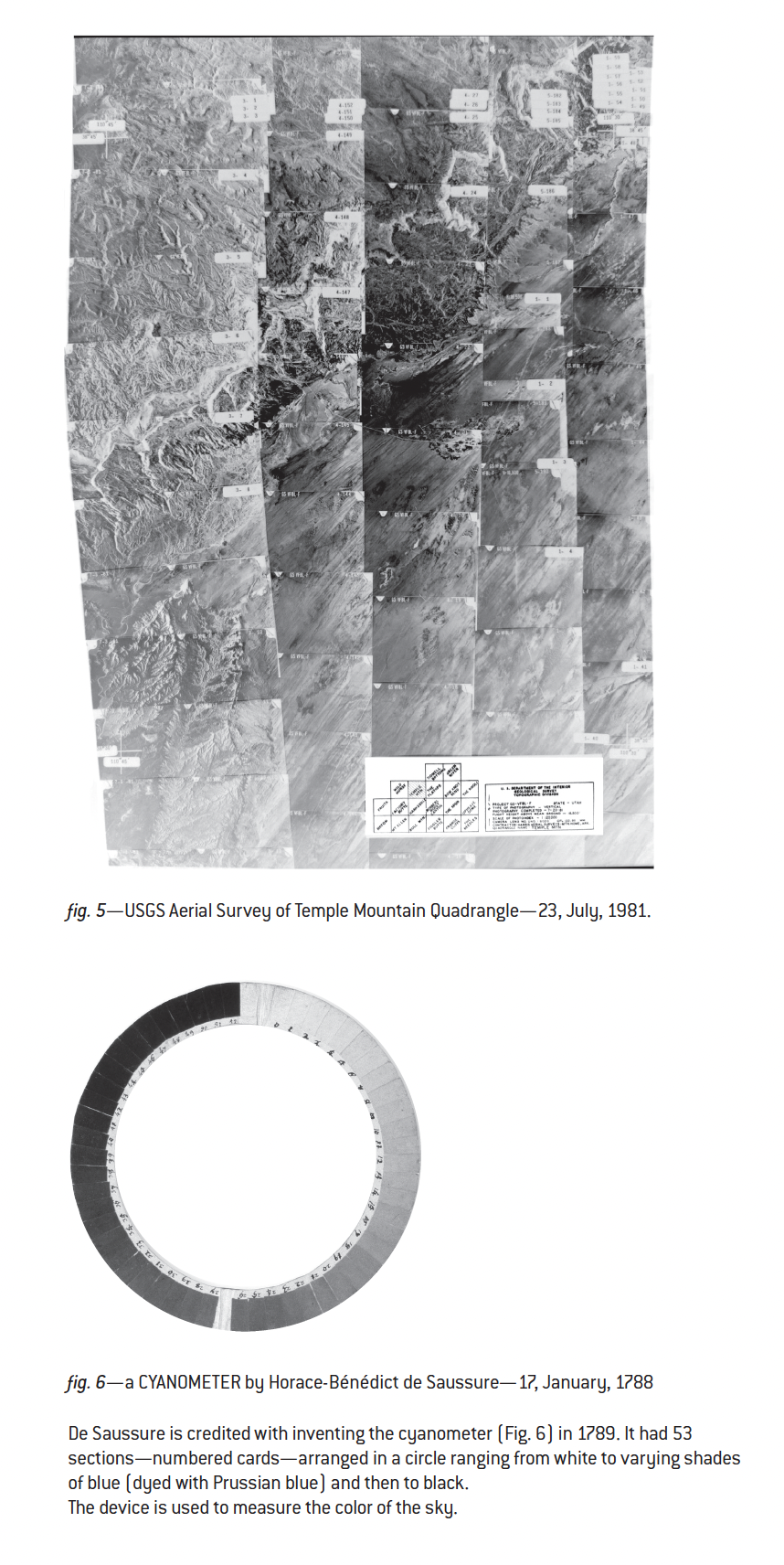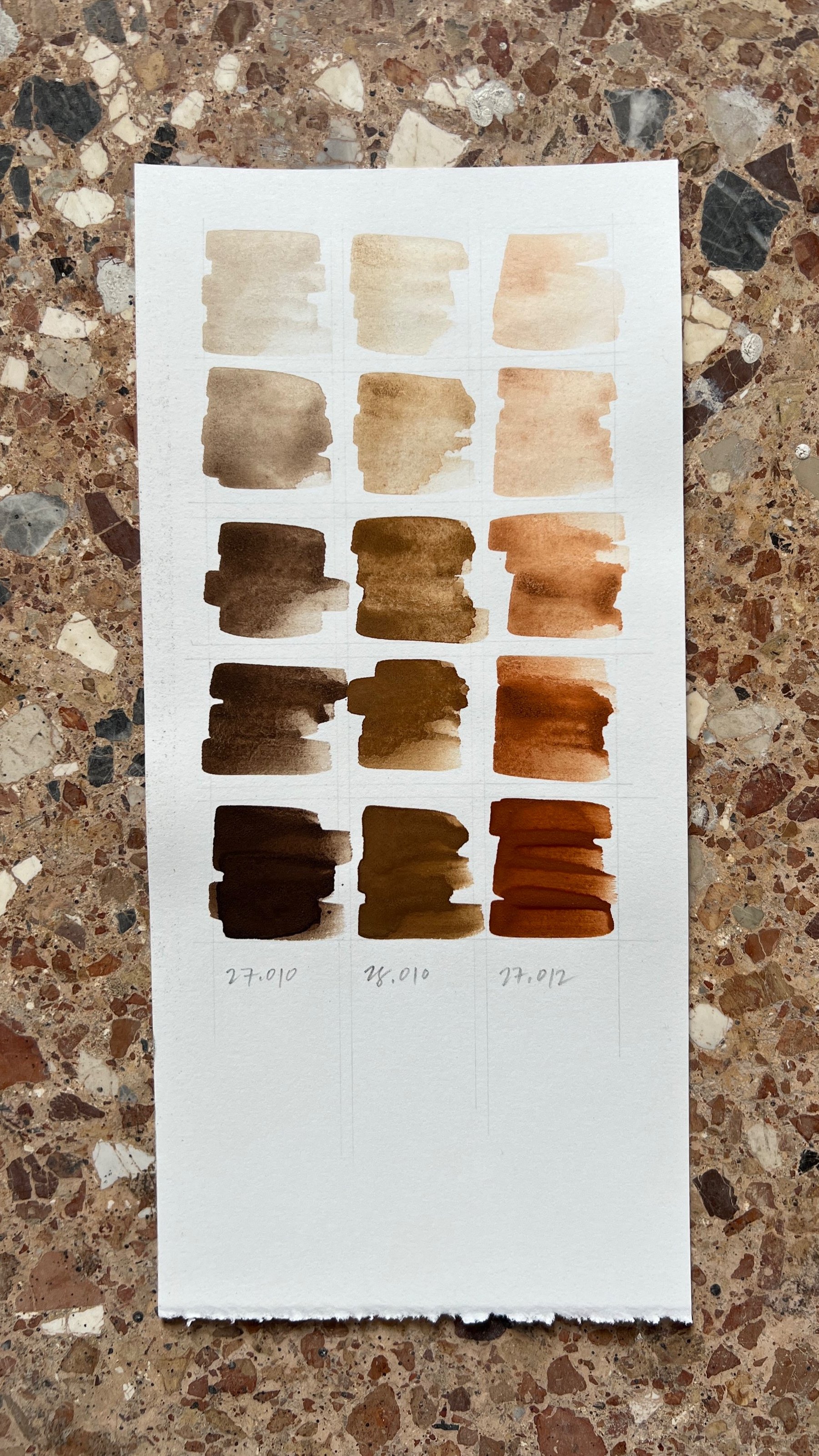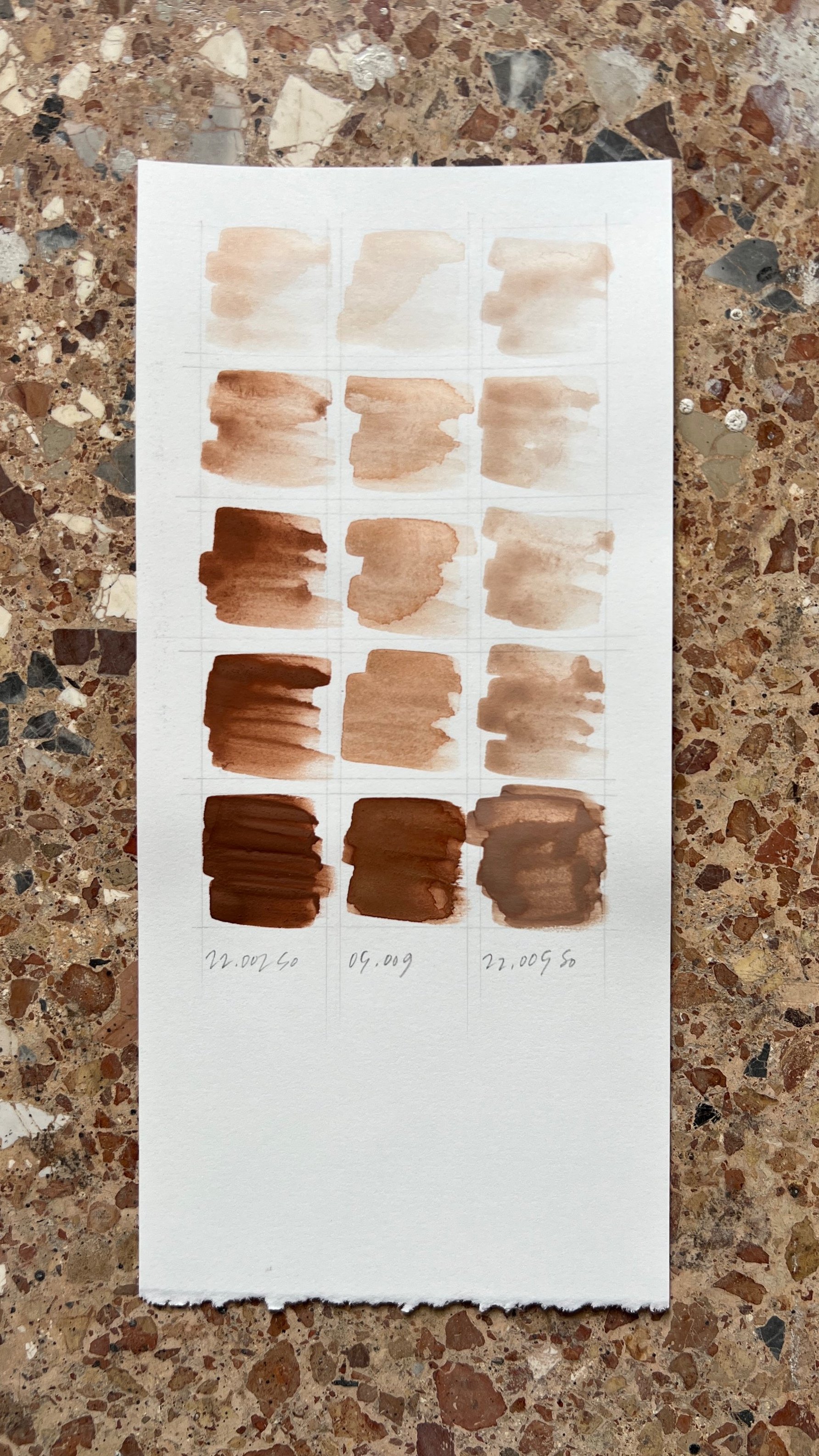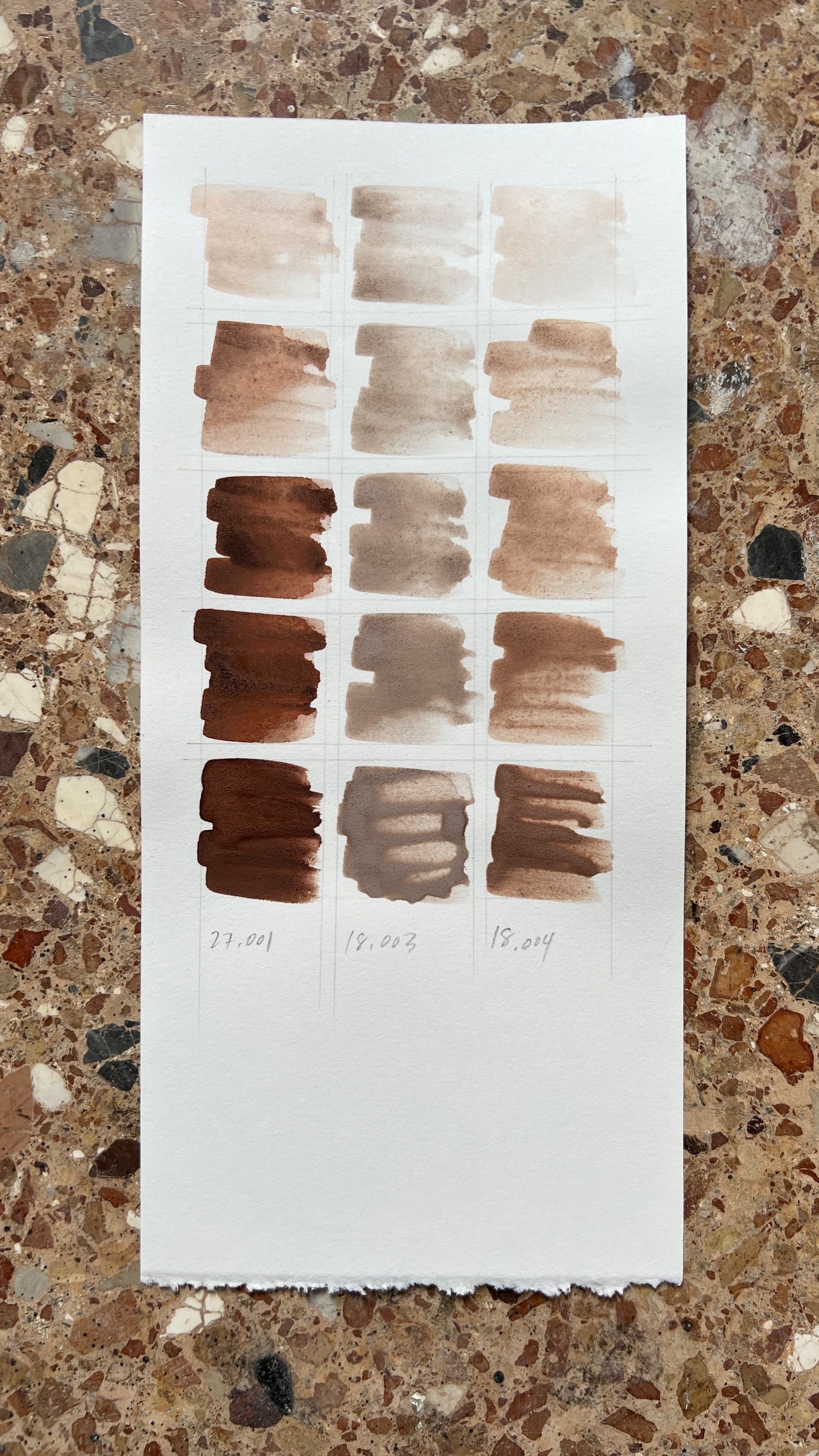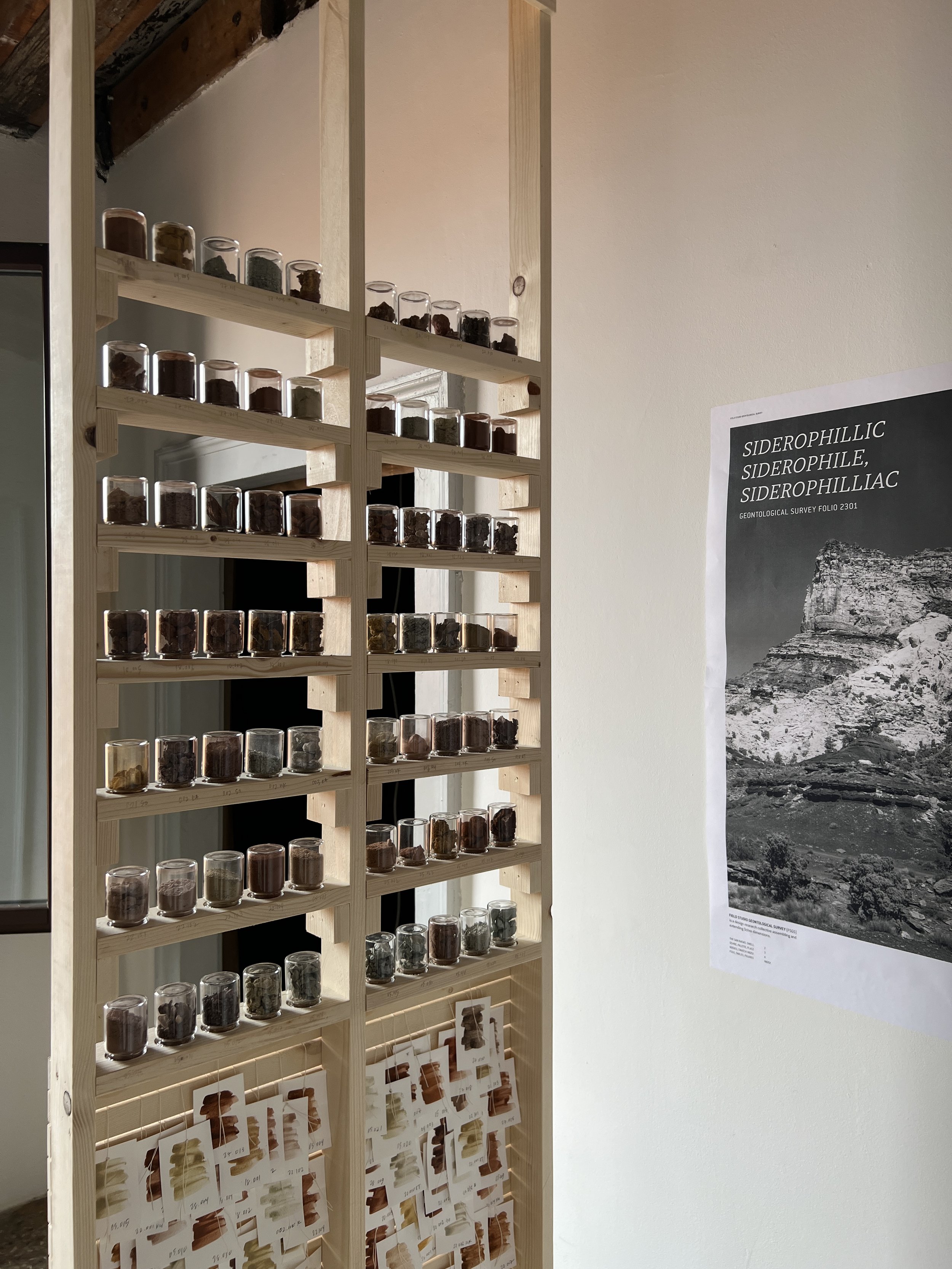
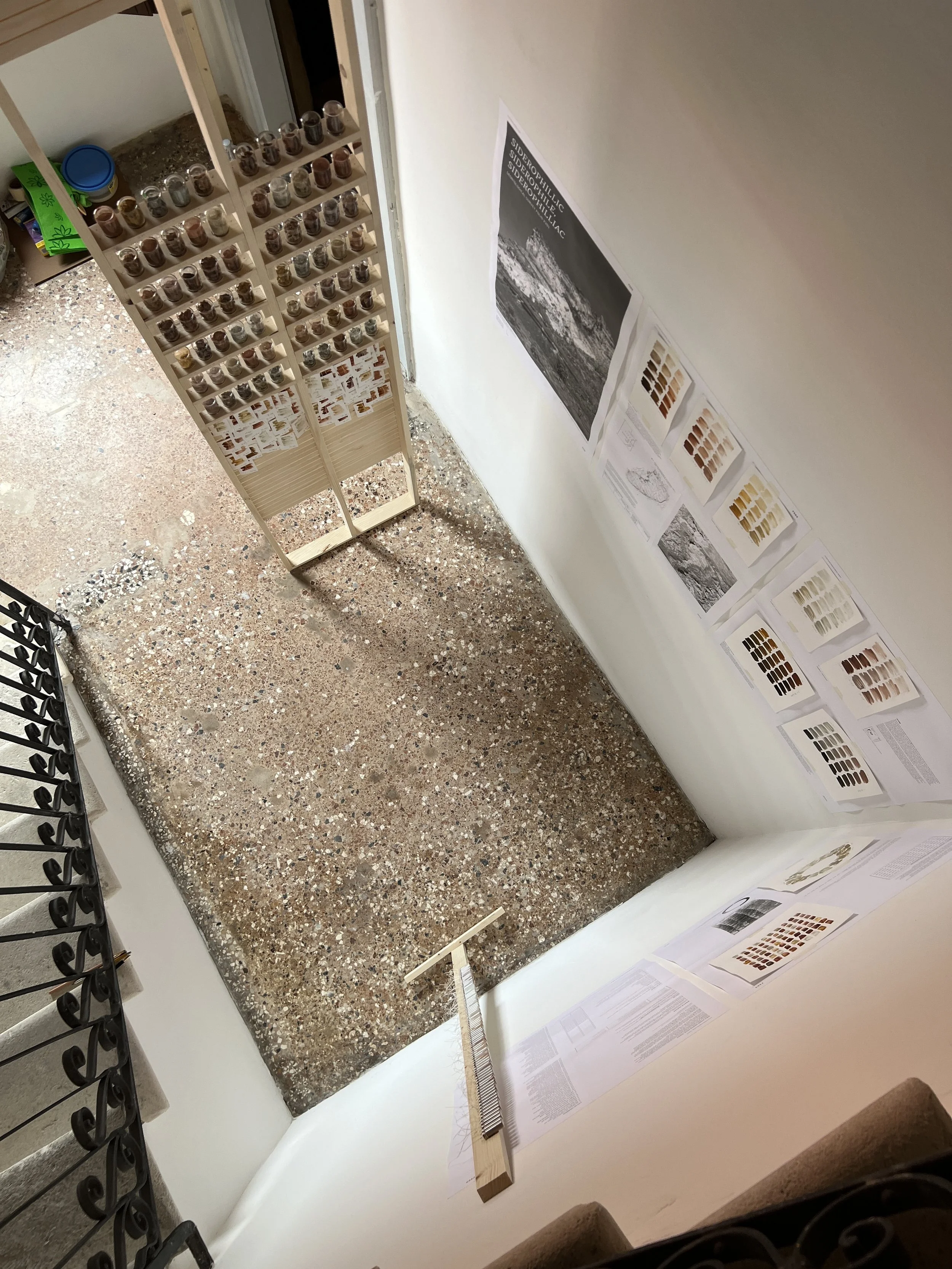
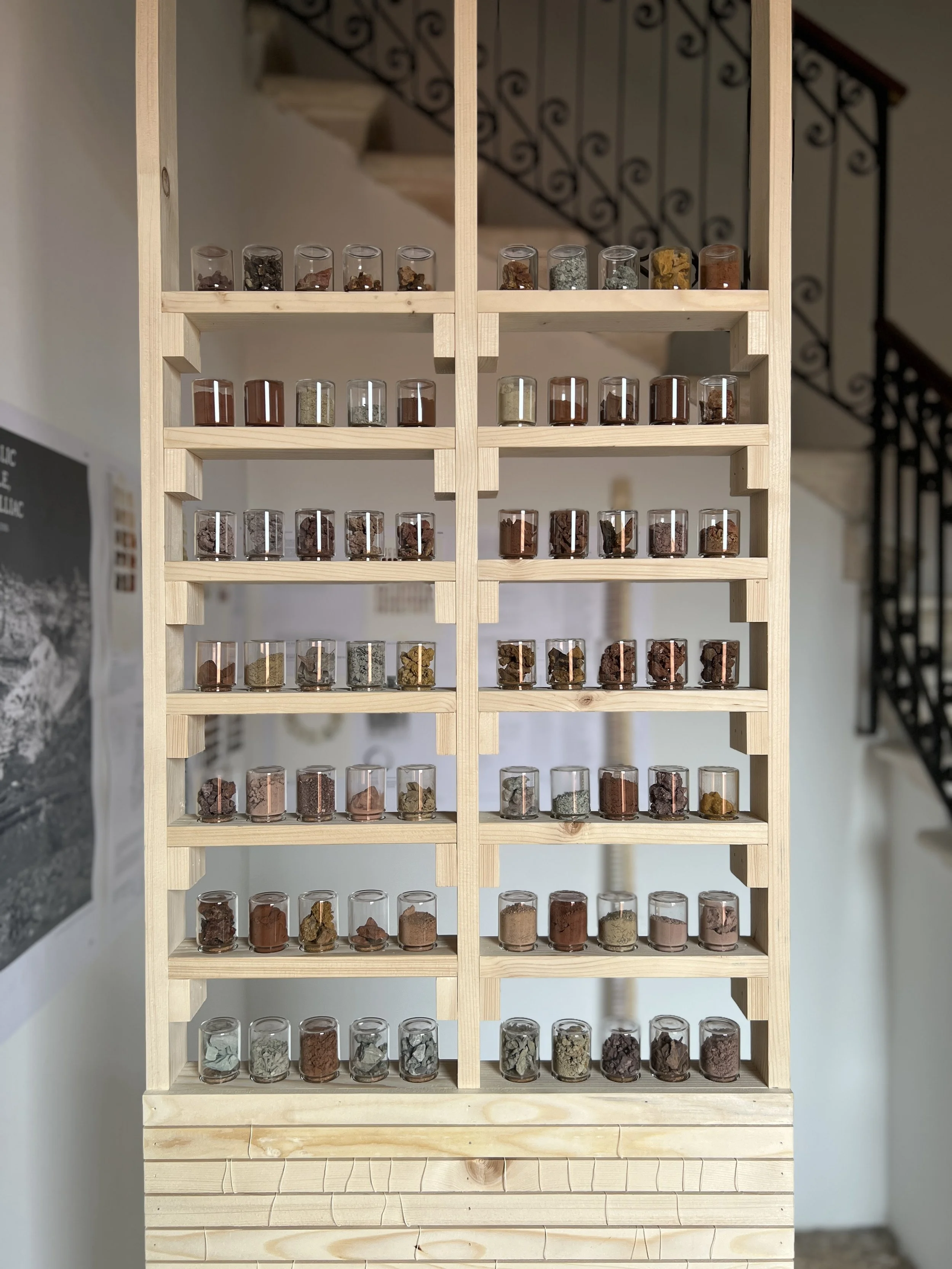
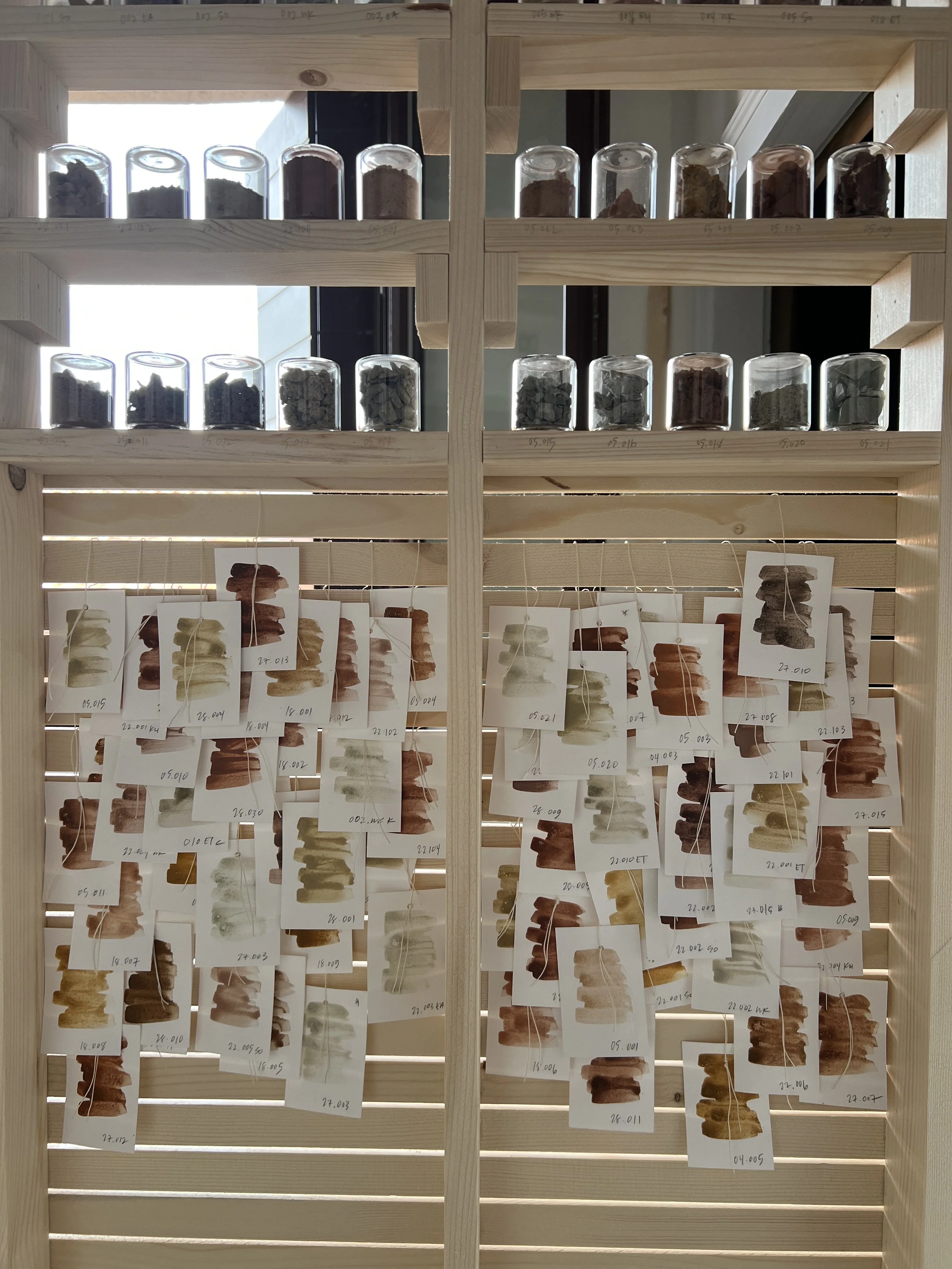

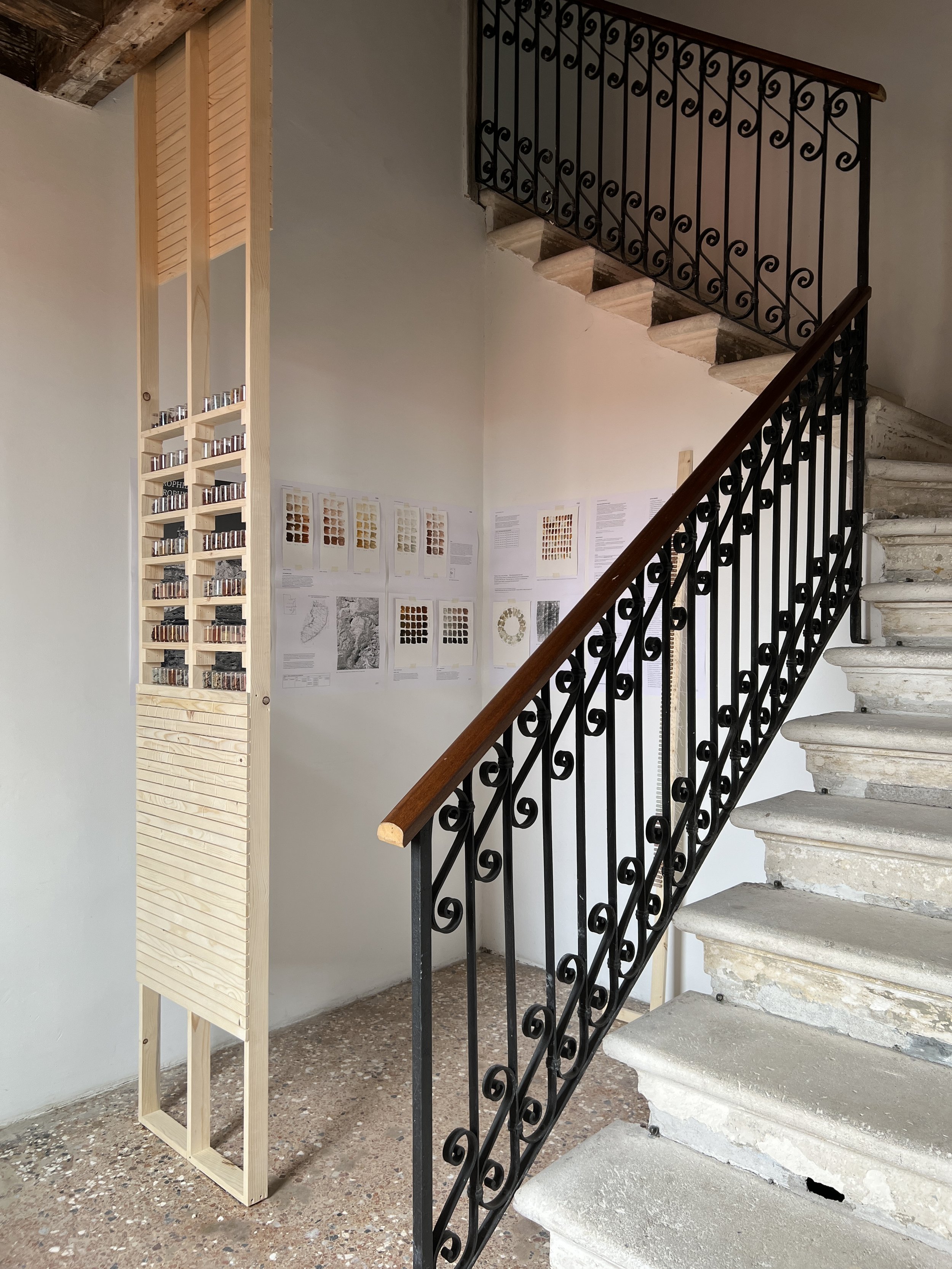
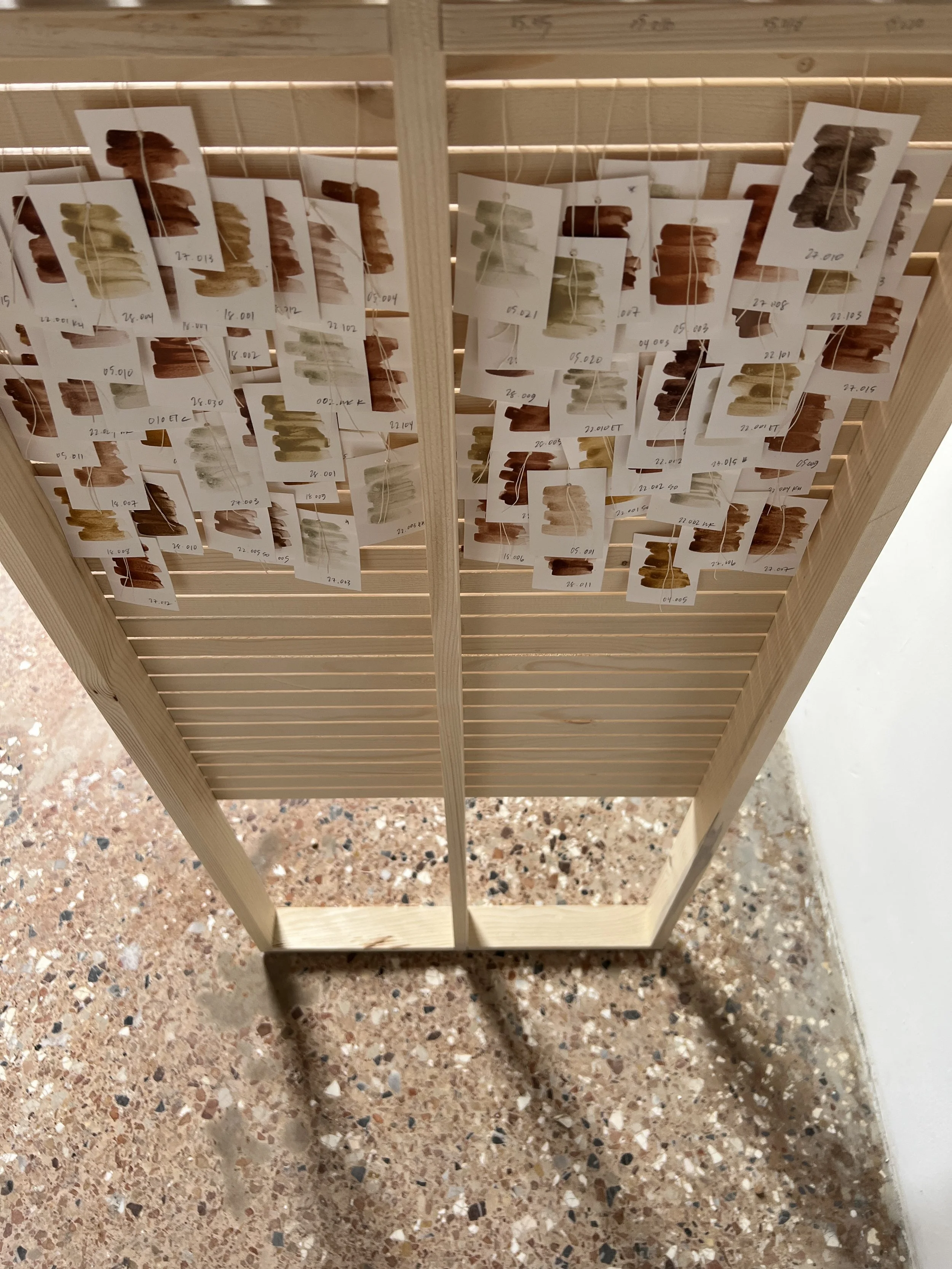
Fig. 1—PHOTOGRAPH OF TEMPLE MTN; COLLAPSE STRUCTURE—Paul W. Ramsey, 2022.
FIELD STUDIO GEONTOLOGICAL SURVEY
FSGS is a bifurcation of practice established by the early land surveys of the mid-19th Century. Those proto-surveys were eventually formalized as the United States Geological Survey (USGS) by act of the United States Congress in 1879. Since then, the USGS has mediated our understanding—and relations to—the nonhuman as raw material or natural resource to be extracted. This constructs dualisms in which humans survey/observe, catalog, map, and publish abstract values of terrestrial beings enclosing the agency of the more-than-human.
FSGS is an anti-colonial, anti-capitalist, feminist practice—an alternative mapping of place in geological time through matter(s) of care. This practice forms relations with geological terrestrial beings instead of positioning them as anonymous resource. It expands the world making capacity of the survey and map, atlas and archive. Grinding minerals is not a sustainable practice. It extends the work of millions of years of geological process as pigment is extended from the Ochre body. FSGS engages the incommensurability that emerges from an assemblage practice that attempts to diverge from extraction logics. Ochre bodies are only sampled from sites of prior disruption—road cuts, tailings piles, and washes where materials are otherwise overturning, in flux.
OCHRE PIGMENTS PREPARED IN COMMUNITY OPERATIONS.
MODES OF PRACTICE
1. FIELD OPERATIONS—in which FSGS collaborators assemble Ochres from sites identified for their entanglements in extraction histories and practices.
2. COMMUNITY OPERATIONS—are gatherings to celebrate and educate. These operations invite the public to participate with Ochre during Ochre Office Hours, participatory demonstrations, and field trips.
3. STUDIO OPERATIONS—where ancient iron sea bed meets modern steel press bed, bodies are extended to pigment and swatch dimensions and FSGS products are manufactured and published.
FSGS agents: Emily Arntsen, Nikki Bennett, Kevin Howard, Will Kershner, Summer Orr, Megan Pettit, and Sam Van Wetter
The Ochre bodies, pigments, and swatches presented here were prepared—in community—by a multiplicity of interlocutors relating to more-than-human worlds.
@geontologicalsurvey
SAN RAFAEL SWELL
So-called Temple Mountain (Fig. 3) is located at the southeast flank of the San Rafael Swell reef (Fig. 5) in the state of Utah in the United States. The Swell (Fig. 2) is a geological anomaly at the edge of the Colorado Plateau. An anticline pushed up 60 million years ago during the Laramide Orogeny. It measures roughly 64 km wide and 121 km long. Erosion has revealed millions of years of geological time exposed to the desert sun along the reef edge. An ancient marine environment left us the Chinle formation in the Triassic Period — a formation marked by colorful instances of oxidation or reduction based on uctuating sea levels and water conditions, tracing soft and friable pigments with variety of hue and memory.
The Colorado Plateau traverses thousands of vertical meters in diverse strati ed layers. Access to these strata is facilitated either by natural erosion and water, or by industrial interventions: road cuts and tailings piles. FSGS practice is enabled by miles and miles of roads that divide and scar the landscape in the name of resource extraction and national progress. The first claims in the Temple Mountain Mining District were as early as the late-19th Century. It became a source of high grade Uranium ore prized by Marie Curie for use in her early experiments. The District reached its peak in the mid-20th Century when miners and their families lived at the site known as “Temple City”. Today, the town-site is a public campground managed by the United States Bureau of Land Management.
PLATE IX—OCHRE SWATCH INDEX—position in the index above corresponds to the position of jars in the opposite wooden structure.
“Make a map, not a tracing. … What distinguishes the map from the tracing is that it is entirely oriented toward an experimentation in contact with the real. The map does not reproduce an unconscious closed in upon itself; it constructs the unconscious.”
OCHRE
Ochre is an iron-oxide mineral pigment. Since Iron is the fourth most common element on the Earth’s surface, it can be found across the globe. Our planet was born of stellar iron dust accumulating into mass from ancient supernovae. This Iron exists today in our earth, in our water, and in our bodies. When it combines with oxygen it transforms into multiple formations of iron-oxide known as Ochre. Ochre is a threshold crossing arbitrary distinctions between life and nonlife. They occur in plural forms, from dense rock to the nest clay dust, as solid or in solution. Humans have been becoming with Ochre since our beginning—as spiritual and cultural agent, and as medicine, tool and technology. Every human culture is entangled with Ochre, despite our current condition in which not every human is in relation with the nonhuman.
Ochre is a multiplicity of more-than-human terrestrial being. It exists on a spectrum that spans the magnitude of geological time to the singular elemental charge. Its bodies are noncontiguous emergent elds that defy Cartesian space and shift with chemical events, heat, or water. Ochre expresses itself in an endless range of chromatic perceptions, or what we might call color. (Plate IX) Color is the agency of Ochre as signified to our human perception. FSGS color theory develops a notion of agency that moves beyond human exceptionalism and anthropomorphism.
The color studies presented here are made with pigment extensions of the Ochre bodies presented on the adjacent structure. (Table 1.) The mini vials contain samples of each entry in the List of Pigments (Index Sheet) prepared in FSGS Community Operations. (Table 3.)
BODIES
Ochre is a body without organs. Table 1 contains 70 discrete body moments assembled from Temple Mountain District by multiple FSGS agents though out various field operations. Iron is a common ancestor our own bodies share with these Ochre bodies—our blood an extension of soil and geology, an extension of the earth. By grinding in the mortar and pestle, erosion is quickened and bodies are reduced to a pigment extension of iron. When pigment is swatched—that is, combined with binder and applied to a substrate—its agency in hue is extended. These extensions offer additional dimensions to understand our worlds beyond Cartesian limits, from the birth and death of ancient stars to the matter of earth below our feet.
PLATE VI—YELLOW TO RED, + IVORY BLACK
PLATE VII—GREEN TO VIOLET, + IVORY BLACK
PALETTE—PLACE
FSGS palettes (Plates I-VIII) become signifier of place, each dependent on a singular moment in time and site. In order to transcend the aesthetic fetishization of so-called pristine or wild nature, FSGS resists imposing redundant representational form on the colors found in place. The critical mapping of color becomes a drawing of nonhuman agency. In this practice, humans are an extension of nature, not separate observers or translators of nature.
There are several sites of assemblage in the District. They include the obvious orientation of geographical place—Temple Mountain—but also the geological marker of time known as the Chinle formation. Signi cant sites within these general territories are the road wash, the bench, the slip, and the bentonite hills, which are technically adjacent to Temple Mountain by about 40 kilometers. Colors can be expressed in discrete hues, but most often are found as potentials ranging from one hue to the next. While heat moves yellow to red, past water conditions determine green from violet.
PLATE VIII—GREEN EARTH-O-METER
“Green earth seals the soul so it can be seen—we are able to keep an eye on it.”
PLATES I TO V—TINT STUDIES













